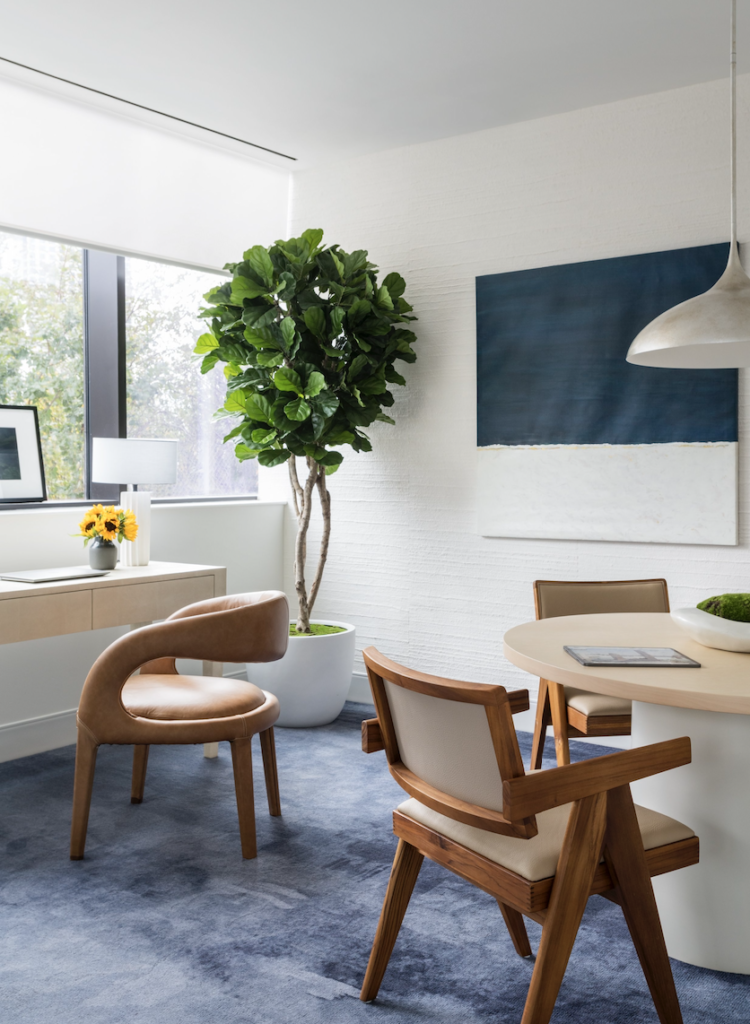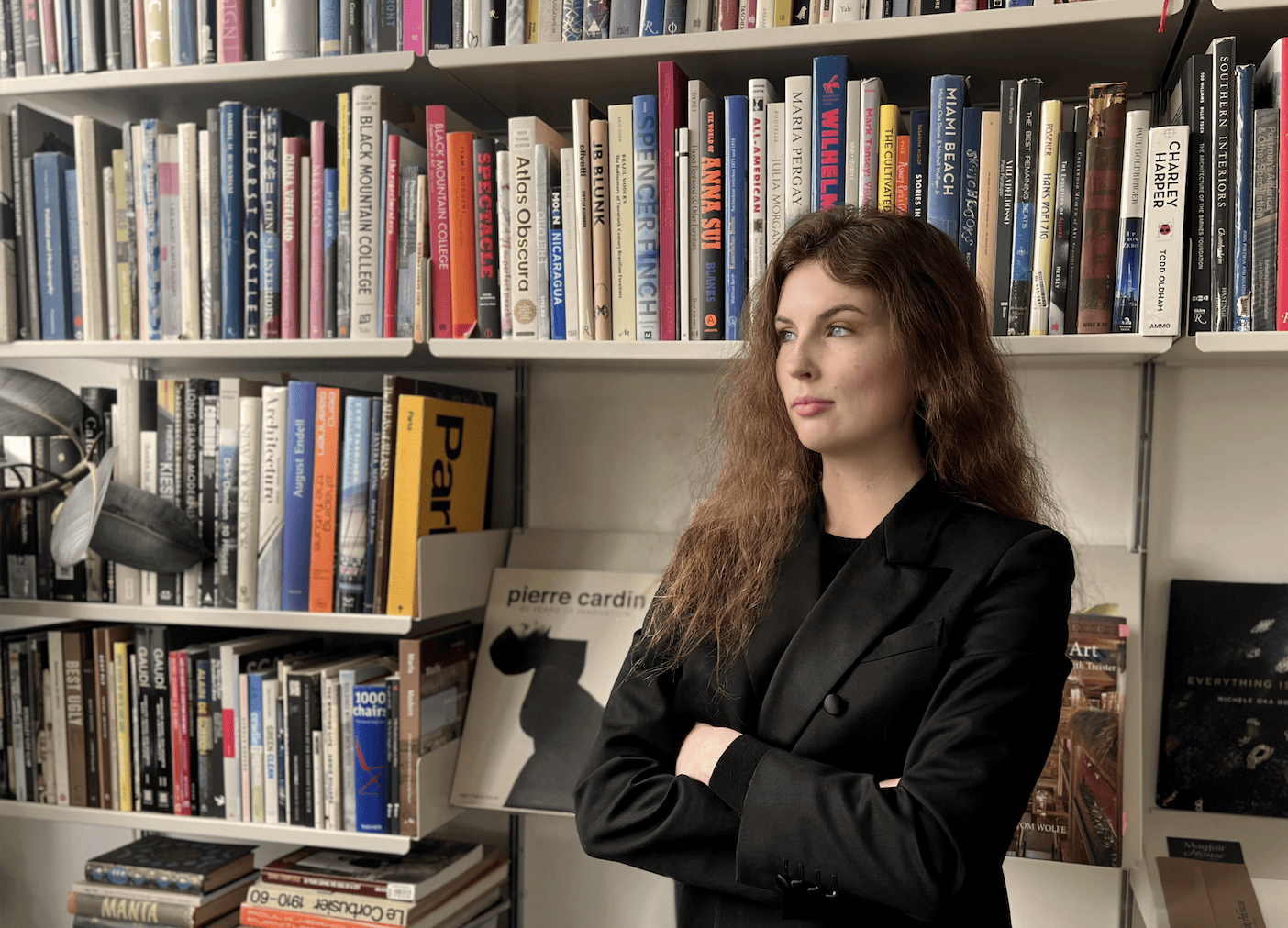The concept design stage is a crucial part of the interior design process, and as many of us know, can be the most fun! After conducting in-depth research, it’s at this point that creative ideation and interpretation take flight. In the early years of a designer’s career, they are not always as involved during this stage of the design process, but many designers flourish when given the task. Recently, we had the opportunity to speak with Sheridan Markham, a young designer who is involved in the concept stage at her firm. She has proven that a fresh perspective, rather than decades of expertise, can bring unique narratives to concept design.
Sheridan Markham, a young female designer at the NYC firm Good,Rich, began her journey with concept design by drawing from her artistic experiences as a musician. She continued her creative journey by getting her BS in Interior Design at FSU, followed by her MFA in Interior Design at SCAD. She excels at tackling large projects and remains undaunted in her creative process. Sheridan has already made a name for herself in interior design, having collaborated on hospitality and corporate projects with names such as Hyatt, IHG, and Google. Before joining the Goodrich team, she managed projects and developed design concepts at BHDM. When Sheridan is not working on a new project, she is an adjunct professor at Florida State University for 3D modeling and rendering.
In the interview with DesignSpec, Sheridan discusses her work process as a multi-talented creator and reflects on her journey toward mastering conceptual ideation in interior design. She also delves into how DesignSpec software came to be an essential part of her daily workflow.
“I love concept design; It played an integral role in my master’s thesis. It changed my perspective on how to think abstractly and influenced me to always keep asking questions.”


Interview:
What was the initial catalyst for you to become a designer?
It wasn’t a completely linear path. When I was in high school, I was in The Leadership Conservatory for the Arts at Tarpon Springs High School. I played the flute for a very long time and I was pretty good at it. I was going to camps all around the country and thought I was going to be a music performance major. I ultimately decided music performance was not going to sustain the lifestyle that I wanted to live. I had to pick something else, and my parents recommended that I try the interior design program at FSU because they knew I was a creative person. So I delved in, and initially, I didn’t like it (only because my parents suggested I do it). I eventually grew to love and appreciate it, and here I am today. Big shoutout to Mom and Dad!
Tell us a bit about your current position at Goodrich.
As a Designer at Good,Rich I get to touch every facet of a project. I recently reshaped and developed the concept for a maritime project, then refined it based on feedback from the team. Currently, I’m helping design key experiences inside this project, which happens to be a cruise ship. It has been challenging but has opened my eyes to a whole new approach to design. I also work on specs of course, selecting materials and furniture.
I love concept design; it played an integral role in my master’s thesis. It changed my perspective on how to think abstractly and influenced me to always keep asking questions. The concept of a project is really important to me, and I’m very grateful that my team gives me the freedom to help develop them.
What do you think is specifically unique about Good,Rich?
I think everyone is just so talented, which is a beautiful thing to be around. And everybody gets the same amount of opportunities at Good,Rich, regardless of their level of experience. We have many different perspectives and a great degree of collaboration, which makes for a rich, creative environment.
“Everybody gets the same amount of opportunities at Good,Rich, regardless of their level of experience.”


Tell us a bit about your experience designing hotels.
I love hotel projects. I think there’s something amazing about being able to make a hospitality space impactful, even if there is a limited budget. Many people think it’s glamorous to work in hospitality design, but oftentimes we are workshopping cost-effective, yet beautiful solutions to successfully portray a brand’s identity. Sometimes, we have to be very creative, and even hands-on! There’s nothing a glue gun can’t solve!
What has been the most rewarding project you’ve completed to date?
I’m really proud of a hotel project that I executed with my last firm, BHDM. It was a project I completed before I left for Goodrich. Hotel Avante, a property of Hyatt, is just outside of San Francisco and was nominated for Gold Key and Best of Year awards this year. I led the project with my director, Sheila Cahill, who was supporting me the duration of the project. It was my first taste of hospitality design and I was excited to do more.
“Many people think it’s glamorous to work in hospitality design, but oftentimes we are workshopping cost-effective, yet beautiful solutions to help celebrate a brand’s identity.”
You mentioned that you recently started working on the conceptual side of things. How do you start your conceptual ideation?
Goodrich has a methodical approach to concept design. There are four pillars that serve as the foundation and help guide every facet of a project. The pillars are: aspirational, familiar, historical, and the muse. Each pillar aims to identify unique characteristics or references that support the brand, site location, and end goal for a project. We look to them throughout every phase of a project, and when a project is finished, the subtle nuances from each pillar help bring a space to life, as well as a holistic experience for the user.


What was the most surprising aspect of becoming a designer that you didn’t initially expect?
You need to have patience and compassion. Finding the balance between being productive and giving yourself time to recharge is a must. Over the years, I’ve learned that although what we do is very important, you cannot sacrifice your mental well-being for it. It is okay to have a stopping point where you are ‘pencils down’ and moving on to the next task. At the end of the day, we are all doing our best and working towards the same common goal; to provide outstanding projects for our clients.
Another surprising aspect of the design industry is how male-dominant it can be. While on-site, I’m often the only female and one of the youngest contributors. I try to find the balance of gaining people’s respect, while also knowing that I deserve respect regardless of my appearance or gender. I try to exude confidence in everything I do, whether it’s on a job site or in an office.
“Finding the balance between being productive and giving yourself time to recharge is a must.”


What would you say you spend the most time doing as a designer, and when does spec writing come into that?
I would say I spend most of my time doing documentation in CAD and sometimes Revit, as well as doing FF&E polls. I develop the color scheme and the palette for a project, and that goes hand in hand with writing the specs. I make sure the specs are a hundred percent polished and ready for our CD submittals.
What role does DesignSpec play in your work?
The software is very intuitive. Sometimes we have an intern or another team member who needs to jump on a project and understand it quickly. People don’t have to go searching for answers; everything is just right in front of them. DesignSpec helps me streamlinethe process of generating specs and visualizing specs as I create them in a project.
What is your favorite DesignSpec feature or function?
I would say being able to create a custom template is my favorite feature of DesignSpec. It’s so easy to create new templates or carry over existing ones. I especially like that you can just drag and drop different attributes to create a template tailored to your project. There’s value in having access to a customizable experience.
“DesignSpec helps me streamline the process of generating specs and visualizing specs that are all in a project.“
DesignSpec places a high priority on refining its existing features while continuously introducing new ones based on user feedback. The latest software release PRO Tier, offers numerous powerful features for teams seeking faster, more efficient specification writing and greater control over their projects. The platform is built for designers like Sheridan with multiple contributors and projects on the go. With a new product catalog in the works, designers will be able to browse both well-known vendors and discover unique products right within the DesignSpec system.
Big thanks to Sheridan for taking the time to speak with us, and to share her story. You can find out more about Sheridan Markham on Linked In.
All photography Adam Macchia.




